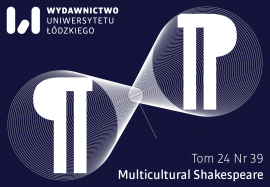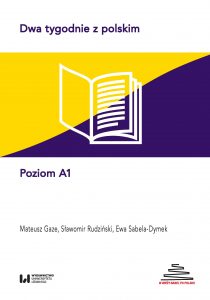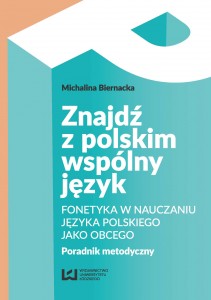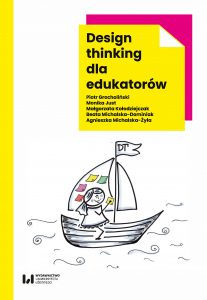Multicultural Shakespeare: Translation, Appropriation and Performance | Tom 24 Nr 39: Thematic Volume: Shakespeare Our Posthumanist
Opublikowano: 29 March 2022

Multicultural Shakespeare: Translation, Appropriation and Performance jest periodykiem o zasięgu międzynarodowym, poświęconym studiom szekspirowskim. Od 2003 wydawany jest przez Wydawnictwo Uniwersytetu Łódzkiego, red. Yoshiko Kawachi, Krystyna Kujawińska Courtney (ORCID). Wcześniej, tj. od 1972 ukazywał się jako Shakespeare Translation; od 1986 jako Shakespeare Worldwide: Translation and Adaptation, red. Yoshiko Kawachi.
Multicultural Shakespeare: Translation, Appropriation and Performance stanowi forum, dzięki któremu naukowcy, zwłaszcza pochodzący z krajów nieanglojęzycznych, mogą analizować lokalne zagadnienia, przyczyniając się tym samym do zrozumienia Szekspira jako globalnego fenomenu. Periodyk stwarza możliwość spojrzenia na uniwersalny wymiar dzieł Szekspira, wydobywając ich lokalne wartości kulturowe np. australijskie, brazylijskie, chińskie, finlandzkie, francuskie, niemieckie, greckie, izraelskie, japońskie, koreański, polskie, rumuńskie, rosyjskie, hiszpańskie, czy też amerykańskie i brytyjskie. Istotnym elementem w publikacjach jest ontologiczne i międzykulturowe znaczenie dzieł Szekspira.
Kabbalah, “Dybbuks”, and the Religious Posthuman in the Shakespearean Worlds of “Twin Peaks”
Lisa S. Starks
In the series Twin Peaks, Mark Frost, David Lynch and others create a mythological framework structured by and filtered through Shakespeare in a postsecular exploration of the posthuman. Twin Peaks exemplifies a cultural postsecular turn in its treatment of the posthuman, taking the religious and spiritual perspectives to new —and often extreme—heights in its use of Kabbalah and other traditions. Twin Peaks involves spiritual dimensions that tap into other planes of existence in which struggles between benign and destructive entities or forces, multiple universes, and extradimensional, nonhuman spirits question the centrality of the human and radically challenge traditional Western notions of being. Twin Peaks draws from Shakespeare’s expansive imagination to explore these dimensions of reality that include nonhuman entities—demons, angels, and other spirits—existing beyond and outside of fabricated, human-centered worlds, with the dybbuk functioning as the embodiment of the postsecular religious posthuman.
The Myth of Total Shakespeare: Filmic Adaptation and Posthuman Collaboration
Seth Lewis
The convergence of textuality and multimedia in the twenty-first century signals a profound shift in early modern scholarship as Shakespeare’s text is no longer separable from the diffuse presence of Shakespeare on film. Such transformative abstractions of Shakespearean linearity materialize throughout the perpetual remediations of Shakespeare on screen, and the theoretical frameworks of posthumanism, I argue, afford us the lens necessary to examine the interplay between film and text. Elaborating on André Bazin’s germinal essay “The Myth of Total Cinema,” which asserts that the original goal of film was to create “a total and complete representation of reality,” this article substantiates the posthuman potentiality of film to affect both humanity and textuality, and the tangible effects of such an encompassing cinema evince themselves across a myriad of Shakespearean appropriations in the twenty-first century (20). I propose that the textual discourses surrounding Shakespeare’s life and works are reconstructed through posthuman interventions in the cinematic representation of Shakespeare and his contemporaries. Couched in both film theory and cybernetics, the surfacing of posthuman interventions in Shakespearean appropriation urges the reconsideration of what it means to engage with Shakespeare on film and television. Challenging the notion of a static, new historicist reading of Shakespeare on screen, the introduction of posthumanist theory forces us to recognize the alternative ontologies shaping Shakespearean appropriation. Thus, the filmic representation of Shakespeare, in its mimetic and portentous embodiment, emerges as a tertiary actant alongside humanity and textuality as a form of posthuman collaboration.
Horrible Imaginings: Jan Kott, the Grotesque, and “Macbeth, Macbeth”
James Tink
Throughout Jan Kott’s Shakespeare Our Contemporary, a keyword for the combination of philosophical, aesthetic and modern qualities in Shakespearean drama is “grotesque.” This term is also relevant to other influential studies of early-modern drama, notably Mikhail Bakhtin’s idea of the carnivalesque, as well as Wolfgang Kayser’s psychoanalytic criticism. Yet if this tradition of the Shakespearean grotesque has problematized an idea of the human and of humanist values in literature, can this also be understood in posthuman terms? This paper proposes a reading of Kott’s criticism of the grotesque to suggest where it indicates a potential interrogation of the human and posthuman in Shakespeare, especially at points where the ideas of the grotesque or absurdity indicate other ideas of causation, agency or affect, such as the “grand mechanism” It will then argue for the continuing relevance of Kott’s work by examining a recent work of Shakespearean adaptation as appropriation, the 2016 novel Macbeth, Macbeth by Ewan Fernie and Simon Palfrey which attempts a provocative and transgressive retelling of Macbeth that imagines a ‘sequel’ to the play that emphasises ideas of violence and ethics. The paper argues that this creative intervention should be best understood as a continuation of Kott’s idea of the grotesque in Shakespeare, but from the vantage point of the twenty-first century in which the grotesque can be understood as the modification or even disappearance of the human. Overall, it is intended to show how the reconsideration of the grotesque may elaborate questions of being and subjectivity in our contemporary moment just as Kott’s study reflected his position in the Cold War.
Przemysław Pożar
The paper proposes to appreciate the play’s butcheries as an incision into the unstable character of the category of the human. The vividness of the “strange images of death” is thus analysed with reference to the cultural poetics of Elizabethan theatre including its multifarious proximity to the bear-baiting arenas and execution scaffolds. The cluster of period’s cross-currents is subsequently expanded to incorporate the London shambles and its presumed resonance for the reception of Macbeth. Themes explored in the article magnify the relatedness between human and animals, underscore the porosity of the soon to turn modern paradigms and reflect upon the way Shakespeare might have played on their malleability in order to enhance the theatrical experience of the early 17th century. Finally, the questionable authority of Galenic anatomy in the pre- Cartesian era serves as a supplementary and highly speculative thread meant to suggest further research venues.
Robert Sawyer
This essay presents a posthumanist reading of Shakespeare’s The Tempest and Marlowe’s Doctor Faustus, two plays which feature a scientist/magus who attempts to control his environment through personal agency. After detailing the analogy between the agency of posthuman figures and the workings of computerized writing machines, as Katherine Hayles has proposed, my essay shows how Kott’s writing, especially his notion of the “Grand Mechanism” of history, anticipates the posthumanist theories that are currently dominating literary assessments. His critique of The Tempest makes this idea perfectly clear when he disputes the standard notion that Prospero represents a medieval magus; he instead argues that Prospero was more akin to Leonardo DaVinci, “a master of mechanics and hydraulics,” one who would have embraced revolutionary advances in “astronomy” as well as “anatomy” (1974: 321).
“No beast so fierce but knows some touch of pity”: Compassion and the Nonhuman in Richard III
Anne Sophie Refskou
When Lady Anne accuses Richard of cruelty in the wooing scene of act one in Richard III, she claims that even the fiercest beast will demonstrate some degree of pity. Her attempt to categorize Richard as somehow both less than human and less than a beast, however, leaves her vulnerable to Richard’s pithy retort that he knows no pity “and therefore [is] no beast” (1:2:71-2). The dialogue swiftly moves on, but the relation between the emotional phenomenon known as pity or compassion and the nonhuman, briefly raised in these two lines, remains unresolved. Recent scholarship at the intersection of early modern studies, historical animal studies and posthumanism has demonstrated ways in which the human-animal binary is often less than clearly articulated in the sixteenth and seventeenth centuries. Building on such work, and adding perspectives from the history of the emotions, I look closely at the exchange between Anne and Richard as characteristic of pre-Cartesian confusion about the emotional disposition—in particular compassion—of animals. I argue that such confusion can in fact be traced throughout Richard III and elsewhere in the Shakespeare canon and that paying attention to it unsettles the more familiar notion of compassion as a human species distinction and offers a new way to read the early modern nonhuman.
Superhero Shakespeare in Golden Age Comics
Darlena Ciraulo
Albert Lewis Kanter launched Classic Comics in 1941, a series of comic books that retold classic literature for a young audience. Five of Shakespeare’s celebrated plays appear in the collection. The popularity of Classics Illustrated encouraged Seaboard Publishing to issue a competitive brand, Stories by Famous Authors Illustrated (1949-51), which retold three Shakespearean dramas. Although both these enterprises aimed to reinforce a humanist perspective of education based on Western literature, the classic comics belie a Posthuman aesthetic by presenting Shakespearean characters in scenes and postures that recall Golden Age superheroes. By examining the Shakespearean covers of Classic Illustrated and Stories by Famous Authors, this essay explores how Shakespearean characters are reimagined as Superhuman in strength and power.
Facial Recognition and Posthuman Technologies in Shakespeare’s Sonnets
Robert Darcy
The human face, real and imagined, has long figured into various forms of cultural and personal recognition—to include citizenship, in both the modern and the ancient world. But beyond affiliations related to borders and government, the human face has also figured prominently into biometrics that feed posthuman questions and anxieties. For while one requirement of biometrics is concerned with “unicity,” or that which identifies an individual as unique, another requirement is that it identify “universality,” confirming an individual’s membership in the species. Shakespeare’s sonnets grapple with the crisis of encountering a universal beauty in a unique specimen to which Time and Nature nonetheless afford no special privilege. Between fair and dark lies a posthuman lament over the injustice of natural law and the social valorizations arbitrarily marshaled to defend it.
Jan Kott is Dead, Long Live to the ˂“Hybrid”˃ Critic
Elizaveta Tsirina Fedorova, Jose Saiz Molina, Julia Haba Osca
This article is a little tribute that a drama teacher, an editor and translator and a lecturer in English Literature would like to contribute to this Special Issue in Honour of Professor Dr Jan Kott, the most influential non-English speaking Shakespearean Critic in the second half of the 20th Century and early 21st Century. In the initial part of the essay we will overview Kott’s influence in the development of current Shakespearean tradition(s) in Spain from the early 1970s to the present day. In fact, his writings and critical views on William Shakespeare’s Works have been a decisive point in the development of new approaches to this playwright in some University Departments and Drama Schools in this country. The whole discussion will take the notion of hybrid and hybridization as the point of departure and we will draw some conclusions for discussing new critical thinking in Art (Science) and Humanities.
Ponadto:
Monika Sosnowska, Robert Sawyer – Introduction: Jan Kott and Posthumanist Entanglements
Joseph Campana – Afterword: Posthumanism—Past, Present and Future
Robert Sawyer, Monika Sosnowska – An Interview with Karen Raber: Reflections on Posthumanist Shakespeares
Zeyuan Hu, Jie Tang, Guixia Xie – Book Reviews
Bohdan Korneliuk, Daria Moskvitina, Danielle Byington – Theatre Reviews
ZAPRASZAMY DO LEKTURY!
Komentarze
Ten post dostępny jest także w języku: Polish





